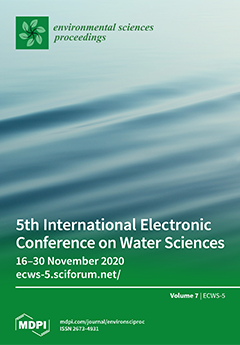Raw and thermally pretreated zeolite, denoted zeolite-T, was examined as a catalyst in the heterogeneous catalytic ozonation process. The catalytic activity was evaluated by the degradation of
p-chlorobenzoic acid (p-CBA) at an initial concentration 4 μM, a typical biorefractory organic model compound.
[...] Read more.
Raw and thermally pretreated zeolite, denoted zeolite-T, was examined as a catalyst in the heterogeneous catalytic ozonation process. The catalytic activity was evaluated by the degradation of
p-chlorobenzoic acid (p-CBA) at an initial concentration 4 μM, a typical biorefractory organic model compound. The results showed that the thermally pretreated zeolite presented higher catalytic activity than the raw material. Rates of 99.3%, 98%, and 94.5% degradation of
p-CBA were achieved within 3 min of reaction/oxidation time, by applying the zeolite-T/O
3, zeolite/O
3, and single ozonation (O
3) procedures, respectively, under comparable experimental conditions. After 15 min treatment time, the concentration of
p-CBA was found to be below the respective detection limit (0.025 μM) of the used analytical method (HPLC) for both catalytic processes, while the application of single ozonation ed to a 0.16 μM residual concentration of
p-CBA. The removal of
p-CBA was also examined for different initial pH values commonly found in natural waters, as well as for different oxidation reaction temperatures. Optimum conditions were defined as a pH value of 8 and 25 °C, during which the production of hydroxyl radicals in the aqueous phase was found to be increased. Furthermore, the degradation of two other common micropollutants (i.e., benzotriazole and carbamazepine), which present different reaction rate constants with ozone (i.e., 20 M
−1·s
−1 and 3 × 10
5 M
−1·s
−1, respectively) was additionally evaluated. It was found that all these micropollutants can be sufficiently removed by the catalytic ozonation system in the presence of zeolite-T. However, it is worth noting that carbamazepine can also be easily removed by the application of even simple ozonation, and that the presence of catalyst simply decreased the necessary oxidation time for sufficient removal. On the other hand, benzotriazole presented a lower ozone degradation rate than the other micropollutants, and, during the early stage (i.e., after the third minute) of the oxidation reaction, it was found to be removed by 96.5%.
Full article



